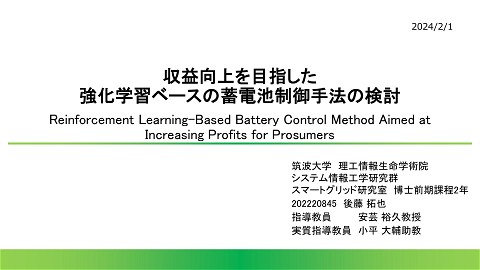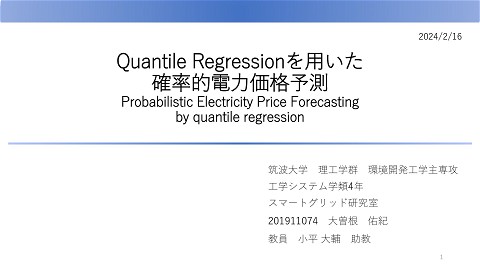2000_Probabilistic Forecasting Model for Non-normally Distributed EV Charging
526 Views
March 31, 22
スライド概要
D. Kodaira and J. Kondoh, "Probabilistic Forecasting Model for Non-normally Distributed EV Charging Demand," 2020 International Conference on Smart Grids and Energy Systems (SGES), 2020, pp. 623-626, doi: 10.1109/SGES51519.2020.00116.
小平大輔 - 筑波大学エネルギー・環境系助教。現在の研究テーマは、電気自動車の充電スケジューリング、エネルギー取引のためのブロックチェーン、太陽光発電とエネルギー需要の予測など。スライドの内容についてはお気軽にご相談ください:kodaira.daisuke.gf[at]u.tsukuba.ac.jp
関連スライド
各ページのテキスト
Probabilistic Forecasting Model for Non-normally Distributed EV Charging Demand Daisuke Kodaira Tokyo University of Science 1
Introduction – EV charging control 02 Scheduling 01 Forecasting Uncertainty • When they arrive and leave? • How much energy demand? • Can EV user book the charge? Various Strategy • Various objective functions • Centralized or Decentralized • Real-time control 03 Dispatch Gap • Unexpected arrival and leave • Forecast error for the demand The performance of EV control relies on the forecasting. How can we evaluate the forecasting quality? 2
Deterministic forecasting EV charging demand kwh The prediction is not always reliable…. Observed Load 6 “Prediction tells us we don’t need to care about the peak today” Predicted Load 0 1 2 3 ・・・・ 23 hour Now EV control strategies cannot reduce the peak appropriately in case the prediction has an error 3
Probabilistic forecasting The concept of probability is necessary to evaluate the risk Prediction Interval (PI) “Prediction tells us the EV demand falls into gray zone with 95% probability” Forecast the demand in Probabilistic manner! 4
Simulation data set • The observed data from Dundee, Scotland from 2017 to 2018 • The charging spots are distributed in 15 km by 30 km square • Forecast total demand in this area (not individual charging points or vehicles) “Electric Vehicle Charging Sessions Dundee.” https://data.dundeecity.gov.uk/dataset/ev-charging-data (accessed Jun. 28, 2020) 5
Simulation data set • All charging transactions are recorded in the original data ChargingEvent UserID CPID StartDate StartTime EndDate EndTime TotalkWh Cost Site Group Model 7751157 601838 50914 6/9/2018 23:55 7/9/2018 7:03 22.287 0 Lochee Charging Hub Dundee APT Controls; CYC; ChargePlace Scotland; Dundee City Council APT 22kW Dual Outlet “Electric Vehicle Charging Sessions Dundee.” https://data.dundeecity.gov.uk/dataset/ev-charging-data (accessed Jun. 28, 2020) 6
Forecasting framework • • • • • One day-ahead forecasting Forecast is obtained in every 15 minutes during one year 96 time slots in a day (15 minutes basis) Forecasting errors in validation data are accumulated for PI composition First step; Deterministic forecasting → Second Step; Probabilistic forecasting 7
Ensemble forecasting k-means clustering Simple Neural network 10 5 0 -10 -5 0 -5 5 10 Year Month Day Hour Quarter DayOfWeek Holiday Charging demand -10 Ensemble forecast is obtained in 15 minutes basis during one year 𝑡𝑖 + 𝑞𝑡 𝐹𝑡𝑖 𝑦ො𝑡𝑖 = 𝑝𝑡 𝐾 𝑡𝑖 and 𝐹𝑡𝑖 are the deterministic forecast by k-means and neural network models 𝐾 𝑦ො𝑡𝑖 is the ultimate deterministic for time slot t on the i-th day 𝑝𝑡 and 𝑞𝑡 are the weight for each model 8
9 Compose Prediction Interval (PI) Deterministic prediction Deterministic prediction Deterministic prediction ・・・・・ Day 2 Probability Day 1 Day 3 Error distribution for 0am~1am Error rate[%] Create PI by Sample-based method Each hour has error distribution respectively The error is obtained by the forecasting in the past 9
Simulation Result for one day Observed demand is in the PI Cover rate is 68% in a day 10
Simulation Result for one month Fig. 8. Prediction interval coverage rate during the forecasting period • 27 days show more than 80% PI coverage rate, but only 37% of the days are over 95% cover rate. Fig. 9. Root-mean-square error during the forecasted 30 days • All the days have more than 5 kWh residual error. This certain residual error is derived from the shortterm fluctuations. 11
Source Codes and Data are available daisukekodaira URL: https://github.com/daisukekodaira/EV-forecasting.git 12
Appendix 13
Data conversion • Ensemble forecasting Start time End time → User1 10:00 Charing 20 kWh 11:00 → User2 10:15 Charing 10 kWh 10:45 Convert Quarter Charging Demand [kWh] Participants 10:00-10:15 5 user1 10:15-10:30 5+5=10 user1, user2 10:30-10:45 5+5=10 user1, user2 10:45-11:00 5 user1 14
Data for the simulation • Normal distribution vs non-normal distribution Fig. 3. Example of a histogram of the EV charging demand from 5 am to 6 am Fig. 4. Example of quantile–quantile plot of EV charging demand from 5 am to 6 am 15
Various PIs example Past Load and PIs Chebyshev Confidence Interval Sample base Each PI has another boundaries. Sample-based method shows the most optimistic one and Chebyshev shows the most pessimistic one 16
Construction of PIs • Window Pick the 5% and 95% data in ascending data as the boundaries. 1 2 3 4 5 6 7 8 9 10 𝑙𝑜𝑤𝑒𝑟 𝑏𝑜𝑢𝑛𝑑𝑎𝑟𝑦 = 10 ∗ 0.05 → 1 𝑢𝑝𝑝𝑒𝑟 𝑏𝑜𝑢𝑛𝑑𝑎𝑟𝑦 = 10 ∗ 0.95 → 10 • Confidence Interval The data is assumed to follow the normal distribution, calculate 95% CI 𝑙𝑜𝑤𝑒𝑟 𝑏𝑜𝑢𝑛𝑑𝑎𝑟𝑦 = 𝜇 − 2𝜎 𝑢𝑝𝑝𝑒𝑟 𝑏𝑜𝑢𝑛𝑑𝑎𝑟𝑦 = 𝜇 + 2𝜎 • Chebyshev Chebyshev’s inequality ensure the certain percentage of data lays in certain range 1 𝑃 𝑥 − 𝜇 ≥ 𝑘𝜎 ≤ 2 𝑘 17





